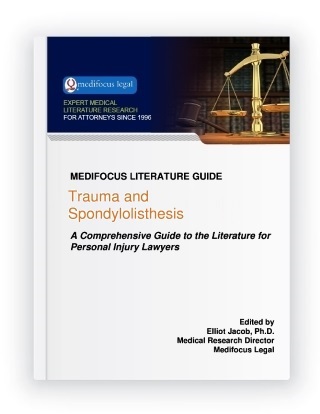Trauma and SpondylolisthesisA Comprehensive Guide to the Literature for Personal Injury Lawyers
Publisher: Medifocus Legal
Publication Date: August 2, 2018
Number of Pages: 126
A Comprehensive Guide to the Literature for Personal Injury Lawyers
Publisher: Medifocus LegalPublication Date: August 2, 2018
Number of Pages: 126
Spondylolisthesis can occur in any region of the spine, but most commonly it affects the lumbar or lumbosacral regions. Symptoms of spondylolisthesis can range from none to severe pain, most commonly low back pain. Compression of a spinal nerve root by a slipped vertebra may also cause radiculopathy, resulting in radiating pain down the affected leg or arm that may be accompanied by tingling, numbness, and weakness.
The most common types of spondylolisthesis include:
1. Degenerative spondylolisthesis - This is the most common type seen in adults ages 40 and above. This condition is caused by degeneration of the intervertebral discs that act as shock absorbers in the spinal column. The most common cause of disc degeneration is aging. The loss of disc integrity due to degeneration increases the risk of slippage of the vertebrae in the affected area of the spine.
2. Isthmic spondylolisthesis - This type of spondylolisthesis is caused by cumulative, small stress fractures that, over time, weaken the vertebrae to the point that it eventually leads to a slip.
3. Congenital spondylolisthesis - The term congenital signifies that this type of spondylolisthesis is present at birth. It is caused by abnormal bone formation that weakens the vertebrae and increases the risk of slippage.
Of particular relevance to personal injury lawyers is the fact that spondylolisthesis can also be caused by a traumatic injury. Although less common than the 3 major types noted above, traumatic spondylolisthesis, also called post-traumatic spondylolistheis, is both recognized and described in the medical literature as a distinct subtype of spondylolisthesis. Most reported cases are traumatic lumbosacral dislocations involving the L5-S1 vertebral segments, however, the literature also documents the development of traumatic spondylolisthesis in the lumbar, cervical, and thoracic regions of the spine.
The MediFocus Literature Guide to Trauma and Spondylolisthesis captures the relevant articles published over the past 25 years regarding the role of trauma as a cause of spondylolisthesis, including the diagnosis and management of traumatic spondylolisthesis. Most of the studies in the literature are based on case series or individual case reports, with a majority of the documented cases of traumatic spondylolisthesis resulting from high-energy trauma, most commonly following motor vehicle accidents or falls from heights. The Guide contains nearly 129 journal article references with links to the article abstracts and includes access to the FREE full-text copies of 22 articles. The Guide will prove to be a valuable addition to the library of any personal injury attorney involved in litigating cases where the role of trauma as a cause of spondylolisthesis may be a central issue.
 |
- A comprehensive bibliography of 129 journal article references indexed in MEDLINE published in well respected medical and scientific journals.
- Online access to the abstracts (summaries) of the articles.
- Online access to the free full-text version of 22 articles.
- Links to full-text sources of other articles that are available for purchase directly from individual journal publishers.
- A unique "Author Directory" consisting of the names and institutional affiliations of experts who have published and have specialized knowledge about Trauma and Spondylolisthesis. The "Author Directory" is a valuable resource for quickly identifying and locating experts for case reviews, opinions, and testimony.
Select examples of topics that are covered by the articles referenced in this Guidebook include:
- Traumatic spondyloptosis: a series of 20 patients.
- Traumatic high-grade cervical dislocation: treatment strategies and outcomes.
- An algorithm for the management of posttraumatic cervical spondyloptosis
- Lumbosacral dislocation: a review of the literature and current aspects of management.
- Traumatic spondylolisthesis of the lumbar spine: a report of three cases
- Traumatic spondyloptosis of the thoracolumbar spine
- Spondylolysis and spondylolisthesis in the athlete.
- Cervical spondylolysis, radiologic pointers of stability and acute traumatic as opposed to chronic spondylolysis.
- Spectrum of imaging findings in hyperextension injuries of the neck.
- Clinical tests to diagnose lumbar spondylolysis and spondylolisthesis: A systematic review.
- Quality of life and disability: can they be improved by active postoperative rehabilitation after spinal fusion surgery in patients with spondylolisthesis?
- Residual neck pain after traumatic spondylolisthesis of the axis.
- Acute traumatic L5-S1 spondylolisthesis.
- The prevalence of cervical spondylolisthesis.
- Acute spondylolytic spondylolisthesis. Risk of progression and neurological complications.
- Prognosis of neurological deficits associated with upper cervical spine injuries.
- Traumatic spondylolisthesis of the lower cervical spine: case report.
- Posttraumatic cervical spondyloptosis at C6-7 with late-onset cord compression: a new clinical entity.
- Effect of major axial skeleton trauma on preexisting lumbosacral spondylolisthesis. J Spinal Disord. 1991 Sep;4(3):353-8.
- Spondylolysis and spondylolisthesis in military parachutists.
is available in two formats: | |
Order by Phone:To order by phone, please call: Order by Mail:To order by mail, please print and complete this Order Form | |

